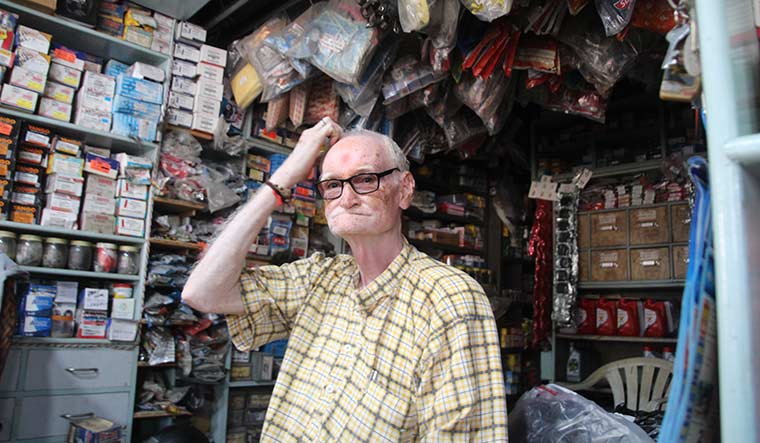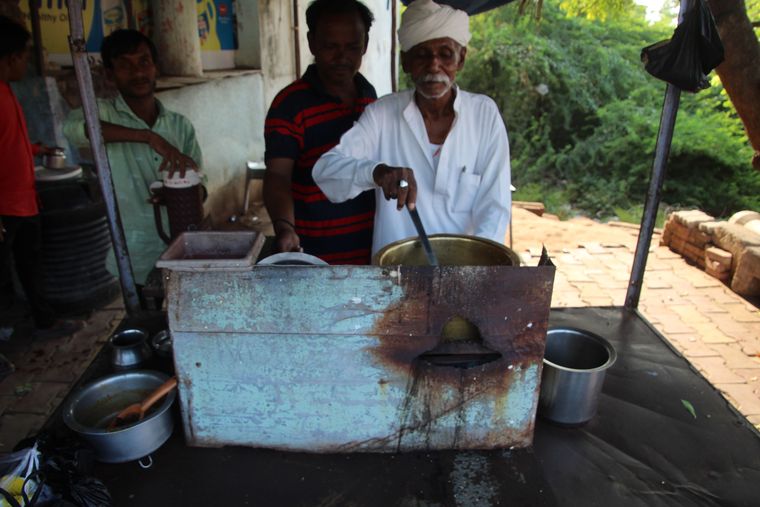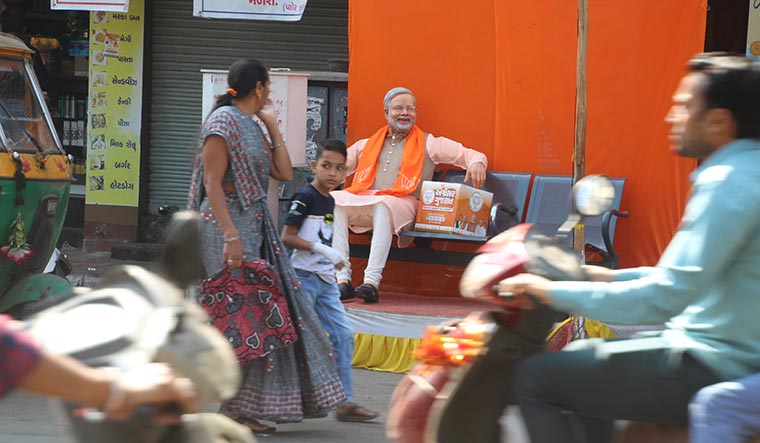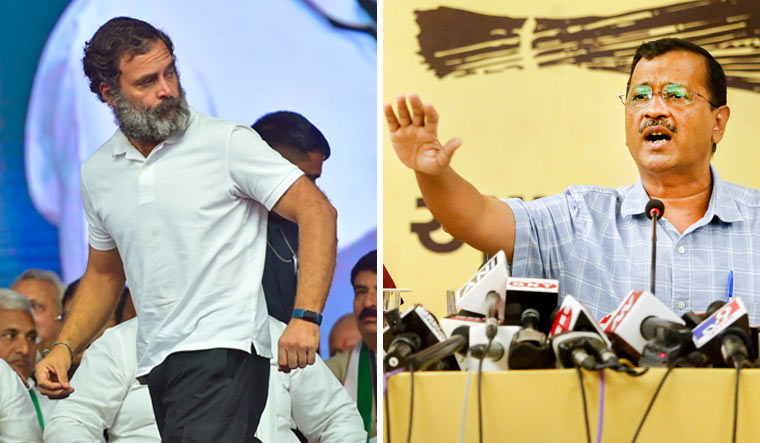She stands in a dingy room she calls home, grinning despite the obvious lack of facilities. For Narmadaben Prajapati, in her mid-60s, the monthly rent of Rs700 gets her more than just a room in a narrow lane in Vadnagar―it gets her the room that Narendra Modi was born in. “I am happy to have come here,” she says, scrutinising some electrical work that is going on.
This home belonged to the prime minister’s aunt. His family home, in a nearby lane, was sold off some time ago.
Prajapati separated from her husband 35 years ago, and now earns by cooking and cleaning in neighbourhood homes. “People like you come. People keep coming,” she remarks, adding that Modi is doing a good job. “I have seen him as a young boy.”
Every house in this north Gujarat town has a Modi story. School, shakha, tea stall, marriage and eventual departure, these are episodic stories that would fit nicely into a Netflix show.
The tea stall, where a young Narendra would help his father out, was moved to Delhi’s Rail Bhawan last month. Its replica is likely to be placed at the Vadnagar station.
Shyamaldas Modi and Shambhu Thakor, in their 70s, recall days with their now-famous friend. “He was brave as a child also. He would jump in the small lake that had many crocodiles. Once he even brought one home,” claims Thakor, who manages a family-owned tea stall.
Modi’s teacher, the 90-year-old Jagdish Naik, also weighs in. “I used to handle 100 children, including Modi, in grade 1. I have taught all his brothers, too. I would not tolerate indiscipline and they always had to sit straight,” he says. Naik met Modi in Navsari earlier this year. “Few words were exchanged, but our eyes talked. Modi told me that he still remembers me,” says the teacher.
His friends always knew Narendra was ambitious. “He was determined about what he wanted,” recalls Shyamaldas, who spent most of his childhood days at the Modi household. He had lost his mother early. “When seven-eight of us would sit to study, he would tell us, ‘You all are duffers’,” he says. “He would also say that he would one day be surrounded by cars.”
Later, when Shyamaldas met chief minister Modi, he quipped that his friend had become Krishna while he had remained Sudama. “Modi replied that it was destiny,” he says.
It is not just Vadnagar. Every town in the state loves Modi, or so the BJP believes. And hopes. In fact, party leaders have called him their Brahmastra ahead of the assembly elections on December 1 and 5. “While getting on and off the stage at meetings, Modi ji meets at least 100 people from the party. He also interacts with a few. This keeps them motivated,” says senior BJP leader Bharat Pandya, whom Modi had spotted as a young man.
With only a year and a half remaining for the Lok Sabha elections, the Gujarat polls are also a referendum on Modi’s popularity. The prime minister wants a record margin of victory. At his first public meeting after election dates were announced, in Kaprada in south Gujarat, Modi said that he would want Chief Minister Bhupendra Patel to break his record. In 2002, after the post-Godhra riots, the BJP had won 127 of 182 seats. The biggest win in Gujarat went to the Congress under Madhavsinh Solanki in 1985―149 seats. Says Pandya: “We have our government at the Centre and a drop in seats in Gujarat will not look good.”
Ever since he first became chief minister, Modi has had the last say in Gujarat.
Known for his surgical experiments, he had, soon after becoming chief minister, denied tickets to all sitting BJP corporators; the party retained power with a thumping majority.
Last year, the entire cabinet, including then chief minister Vijay Rupani, was asked to resign. And earlier this month, about an hour before the party’s central parliamentary board sat to finalise candidates’ names for the assembly elections, Rupani and other former ministers said that they were “not keen” on contesting. This led to speculation that these leaders were told to go public so that there was no awkwardness when they were not given tickets.
With none of the second-rung leaders being popular, Modi has taken it upon himself bring in the voters. And like always, Home Minister Amit Shah is at his side. While Modi plans to be the face, covering a majority of the seats, Shah is the strategist. From holding closed-door meetings to ensuring that rebels withdraw their candidacies, Shah is troubleshooter, taskmaster and firefighter all rolled into one.
But, there are still dissenters. Madhu Shrivastav from Vaghodiya, a six-time MLA and a co-accused in the 2002 Best Bakery case, had won in 2017 with a margin of over 10,000 votes. He was denied a ticket this time, and will contest as an independent. He has, however, said he would support the BJP if he wins.
Dhavalsinh Zala from Bayad, north Gujarat, is also fighting as an independent. A Congress turncoat and then sitting MLA, he had joined the BJP in 2019 along with Alpesh Thakor. The latter has been fielded from Gandhinagar (South). None of the other dissenters who are contesting as independents are likely to harm the BJP’s chances.
Rebellion aside, the BJP has other headaches. The Congress cannot be dismissed. Even at the peak of hindutva after the Godhra riots, the party had won 51 seats.
This time, it has carefully selected candidates, has steered clear of media hype, and is reaching out to the voters through khatla (cot) meetings in the villages. Notably, in one of his meetings, Modi warned his party men that the Congress was trying something different. Rahul Gandhi, who is busy with the Bharat Jodo Yatra, has not been as active in Gujarat as in 2017.
The Congress had reaped the benefits of the Patidar agitation led by Hardik Patel five years ago. It had also done well in the 2015 panchayat elections.
However, ever since the 2017 scare, the BJP has done everything to weaken the Congress. For reasons best known to them, more than two dozen Congress leaders and MLAs have switched to the BJP. Currently, the BJP has 111 MLAs in the assembly. In recent months, three tribal Congress leaders have resigned; they are now contesting on a BJP ticket.
Also, this time, Hardik is in the saffron camp and is contesting from his home town Viramgam, near Ahmedabad.
Several of his colleagues such as Nikhil Savani, Dharmik Malaviya and Alpesh Kathiriya have joined the Aam Aadmi Party, which is emerging as a strong third front in the state. Savani and the others are expecting the Patel community to support them in Surat and parts of Saurashtra.
Buoyed by the Punjab win, chief ministers Arvind Kejriwal and Bhagwant Mann are now seen more in Gujarat than in their own states. Kejriwal has promised 300 units of free electricity a month, a monthly sum of Rs1,000 to women and an unemployment allowance of Rs3,000. The middle class and poor voters have lapped this up. Modi even had to coin the term ‘revdi culture’ to mock this trend and the matter has even reached the Supreme Court. However, in a state that has mostly chosen the BJP or the Congress, it remains to be seen whether Kejriwal’s promises translate into votes.
Also bothering the BJP is a section of government employees and its longstanding demands, including the call to reinstate the old pension scheme. Though the government has given assurances, there is no guarantee that these promises will be kept.
The government also had to withdraw a bill on movement of stray cattle on the streets following pressure from the cattle-rearing Maldhari community. The Centre had to shelve the Par-Tapi-Narmada river linking project following a tribal agitation led by Congress MLA Anant Patel.
Well aware of the challenges its opponents pose, the BJP is trying to offset the losses it may face in other parts of the state by focusing more on southern Gujarat. Shah, in fact, flagged off one of the Gujarat Gaurav Yatras from the region and two of Modi’s initial public meetings have been there.
The recent bridge collapse in Morbi, which killed around 135 people, is also expected to have an impact in the town and nearby areas in Saurashtra.
The contract to maintain the bridge was given to a watchmaking company without a tender and it was opened to the public without a fitness certificate.
The BJP leaders do not admit this on record, but they are wary about the bridge collapse impacting the elections. Though the Gujarat High Court has pulled up the state government, no concrete action has been taken yet. No name has been mentioned in the FIR so far; Gujarat BJP president C.R. Paatil has said that names will be added once the blame is fixed.
The headaches might be bothersome, but Modi is the balm. Even last time, it was the Modi factor that helped the BJP reach 99 seats in the face of a buoyant Congress and the Patidar agitation.
The local BJP leaders had talked about the progress made under Modi; Modi talked about the work his government had done at the Centre. He also spent time explaining to the people why demonetisation―a move that faced backlash―would help unearth black money. His pet topic, however, was the 2016 surgical strike in Uri, which he used to highlight his tough stance against terrorism.
Political analyst Achyut Yagnik attributes the BJP’s victories in Gujarat to the rise of hindutva among the middle class and the work that the Rashtriya Swayamsevak Sangh did; the Congress’s Seva Dal, he points out, is almost defunct. He also points to the rise of many powerful Hindu sects that indirectly support the BJP.
“It is after [former prime minister] Morarji Desai that someone from Gujarat is at the Centre,” he says. “People take pride in this and it will influence voting.”
Modi has been hyperactive in Gujarat in the past few weeks, and the BJP has been playing up his addresses on social media. Attacking his opponents, he has been telling Gujaratis that they should not tolerate anyone trying to malign their state. “If someone from Gujarat succeeds, it pains them,” he says.
Modi is also relying on the emotional connect, asking for people’s blessings as their “son” and dubbing them his “teachers” who have taught him a lot.
There was also a video of a six-year-old girl, seated with Modi, talking about why the BJP should stay in power. Though critics have said that the child was made to learn the speech by rote, the video did go viral.
That Modi knows Gujarat inside out helps him reach out to people all over the state. If he is north Gujarat, he speaks about the Modhera Sun Temple and Rani ki Vav (The Queen’s Stepwell), a world heritage site in Patan. When in Kutch, he speaks of the Mandvi beach and the White Rann, a place that his government made a big tourist attraction.
He also reminds the voters that he is, after all, a son of the soil. The BJP, meanwhile, has painted anything anti-Modi as anti-Gujarat. In response to Congress leader Madhusudan Mistry’s remark that his party would show Modi his aukaat (status), the prime minister said there was no need; everyone knew he was from a humble family and a “servant”. He also brought up earlier taunts of “Maut ka Saudagar (merchant of death)” and “neech (lowly)”, which had helped him get votes in earlier elections.
Notably, both the BJP and the Congress are not acknowledging the AAP as a threat. Modi, in fact, does not even mention the party. While inaugurating India’s first fully solar village Modhera in Mehsana district, he said people do not need free electricity if they switch to solar. In fact, they can earn from it.
Varshaba Kirtisinh Solanki of Modhera has a panel on her roof. She used to get a bill of Rs4,000 every two months; now it is zero. “We have an air conditioner and a washing machine,” says the 40-year-old. “We run these on solar.”
She claims that each of the 4,000 homes in the village has been given solar systems with 1KW capacity for free. “The panels are strong. They are not damaged even if monkeys jump on them,” she says, adding that they get power even during monsoon.
Also read
- Gujarat: Modi mantra of good governance infused with hindutva pays rich dividends
- Modi magic dispels all obstacles to win Gujarat in style
- What led to Congress's decimation in Gujarat
- What can Congress learn from Gujarat loss and Himachal win
- In its local and state level endeavours, AAP aims to achieve its national ambition
- Himachal: 10 guarantees Congress gave to the voter that helped it win
The state BJP is taking several other steps to bolster its chances. C.R. Paatil has introduced the system of page presidents, an extension of the party’s panna pramukh model. In this, a “page committee” of five persons is formed, which will be in charge of around 30 voters each. These five are constantly in touch with the people, helping them out with their problems.
Selfie booths have been created with Modi’s cutouts at several places, and party insiders say there is more to come.
Like all political parties, the BJP, too, works with advertising agencies, but party sources say that the main brain behind their campaigns in the prime minister; the broad themes come from his office.
The slogans Modi announces are the icing on the cake. After ‘Double-engine sarkar’ and ‘Bharosa ni sarkar, BJP sarkar (trustworthy government, BJP government)’, he recently raised the slogan ‘Aa Gujarat mai banavyu che (I have made this Gujarat)’. The ‘I’ here refers to every Gujarati who has worked hard to help their state progress. His critics, however, insist that the ‘I’ means Modi.
On November 20, after a hectic day of campaigning in Saurashtra, Modi suddenly reached the party headquarters in Gandhinagar and held an informal meeting with the party workers. Flanked by Paatil and Chief Minister Patel, Modi sat in an open space on the ground floor, surprising many. He could have chosen the air-conditioned hall. “Such gestures help break the ice and soothe tensions among those who were denied tickets,” says a senior party leader.
Points out political observer Hari Desai: “Modi can mesmerise anyone with his speech and style. He is considered an icon who safeguards the interests of Hindus.” It brings him victory after victory, he says, but adds that his popularity has been going down since 2002, at least in terms of the number of seats the BJP has won in state elections.
He also says that Modi would be able to form the government this time, too, but that he has had to compromise in some areas. Like giving tickets to several turncoats and reaching out to the Sangh Parivar affiliates and even former Vishva Hindu Parishad leader Pravin Togadia.
It is all about holding on to Gujarat. And the duo of Modi-Shah would be desperate to do so.









